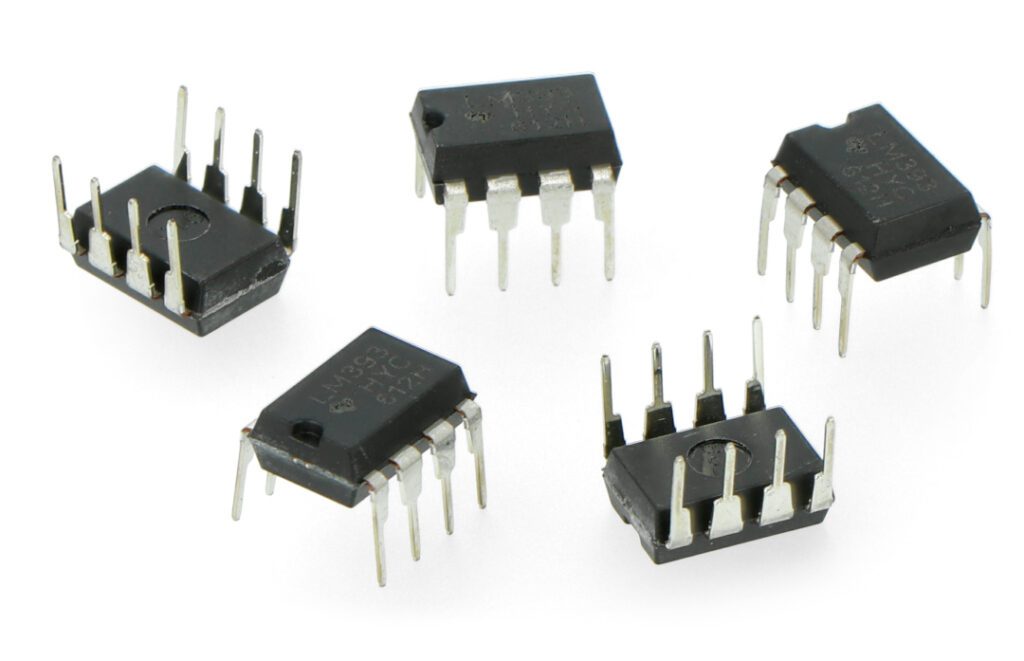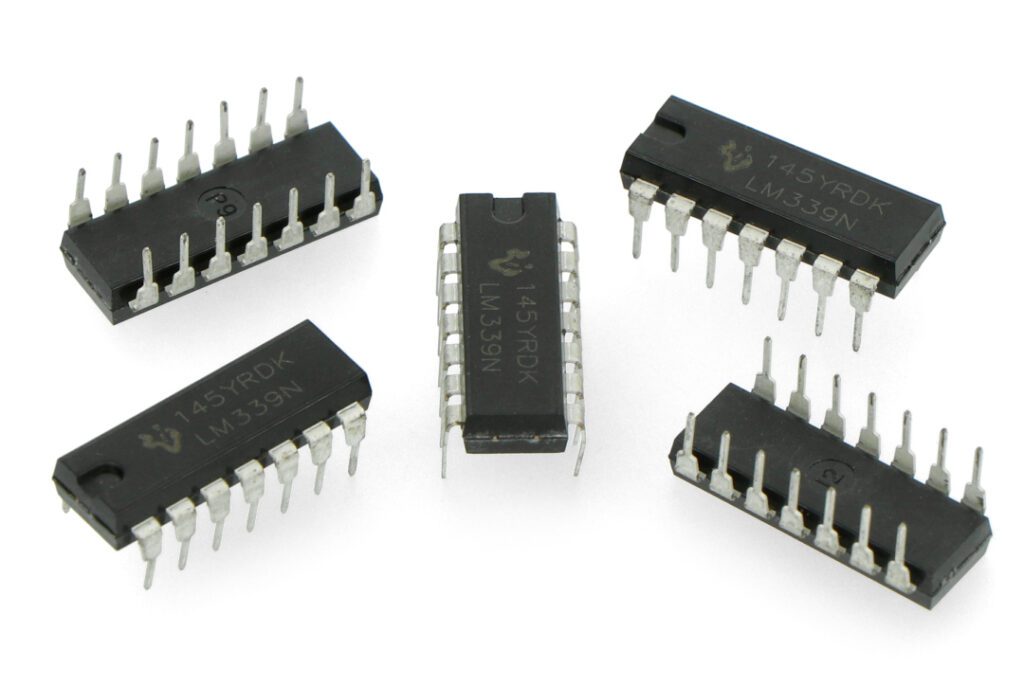Table of Contents:
The LM393 is one of the most widely used comparators. What is this circuit used for and what are its parameters?
What is a comparator?
Before knowing the exact definition LM393 and data on this device, it is worth finding out what the comparator. It is a device included in the group of combinational circuits, that is, circuits in which the values at the output depend only on the current state of the inputs. This is a feature that distinguishes them from sequential systems, where previous input values are also relevant. Different solutions of this type can perform different functions – in the case of a comparator, we are talking about comparing two values.
Depending on the type of measured quantities, two groups of comparators are distinguished. The first is analog comparators, which compare input voltages or currents, delivering the result to a single binary output (0 or 1). The second is digital comparators – their task is to compare binary numbers, i.e. indicating which one is greater or less (or whether both are equal). The circuits in this group have three leads (separate for each possible outcome). The one in the output can only appear on one of them. Digital comparators can be cascaded together to compare binary numbers of any length.
In addition to the basic division into digital and analog comparators, special variants of individual circuits are also distinguished:
- Comparators with an external reference voltage;
- comparators with hysteresis;
- differential comparators;
- Comparators with fast response times.
Each is characterized by certain differences in design, which can translate, for example, into greater signal stability or faster system performance. Devices of this type can be found, among others. in control, threshold detection and signal processing systems, as well as in input-output interfaces, thermostats, reflective sensors or other small electronics.
What is the LM393?
LM393 is a dual differential comparator with 8 pins. It is worth noting that its design actually includes two interconnected analog comparators, each with two inputs (inverting and non-inverting) and one output each (labeled “Output 1” and “Output 2”). It is one of the most popular comparators available on the market, often used by electronics and robotics enthusiasts.
The LM393 comparator
is available in several variants that differ in the range of the voltage to be compared. On the market, you can mainly find models that operate in the range of 2-32 V or 4.5-28 V.
The reference voltage is adjusted by a potentiometer during the measurement. In addition, individual products may differ in terms of performance and technical details. The layout symbol may also be followed by additional letters that help identify specific variants – for example, “The layout symbol”. LM393ADR, LM393N, LM393PT or LM393P.
LM339 a LM393
Looking for comparator LM393, you may also come across listings showing the model LM339. Both systems perform similar functions, but it is important to note a key difference in their design. The LM339 module has twice as many inputs and outputs – in practice, it can be treated like two LM393 chips connected together.
Such equipment can serve as a quadruple operational amplifier. The differences may also apply to the input voltage range, but this parameter depends on the specific model of the circuit.
Technical data LM393
In terms of technical data, it should be remembered that there are different variants of the LM393 comparator available on the market, which may have slight differences regarding performance. It is worth carefully analyzing the available options, since even small deviations from the required values can significantly affect the operation of the entire system. The standard LM393 comparator is a product with the following characteristics:
- number of channels – 2;
- housing format – DIP-8;
- Supply voltage – from 2 V to 36 V (DC);
- response time – approx. 300 ns;
- Operating temperature range – from 0 to 70°C;
- mounting method – THT;
- Outputs compatible with TTL, DTL and CMOS logic systems.
LM393 schematic
Before connecting the LM393 comparator to your device or implementing it in projects in the field of electronics or robotics, it is a good idea to carefully study the schematic of this circuit. This allows you to determine precisely how to combine it with other components. This in turn will take care of the effective use of the comparator and its functionality. LM393 schematics can show the device alone or the circuit connected to other hardware. Focusing on the LM393 itself, however, we have 8 pins available:
- On the left – output 1, input 1 (positive and negative pin) and ground;
- On the right – Vcc pin (power supply), output 2, input 2 (positive and negative pins).
The internal part of the circuit consists of interconnected operational amplifiers. These are components that allow you to convert a relatively small voltage to a larger value, which in the case of comparators allows you to accurately and reliably compare the state of the inputs.
How much does an LM393 comparator cost?
The LM393 comparator is a relatively simple, small circuit that comes at a very low price. Typically, we will pay between £1 and £2 for a device of this type. A good idea would be offers with comparator kits, containing, for example LM393 modules. This not only allows you to save a little, but also protects you in case one of the components is lost or damaged.
LM393 - opinions
The LM393 is a comparator appreciated primarily for its attractive price, versatile application, ease of use and hassle-free availability in stores. These types of circuits will be very useful for both professionals and people who are just beginning their adventure with robotics and electronics. With their use, you can build, among other things. simple sound modules or light sensors, as well as many more advanced devices.
Buy LM393 comparator at Botland store
We prepare our offer to meet the requirements of all lovers of robotics and electronics. In the assortment Botland also featured numerous comparator variants – including the LM393 version of the LM393P. These are small, but very useful systems that allow you to implement a wide variety of functionalities – feel free to buy!
How useful was this post?
Click on a star to rate it!
Average rating 0 / 5. Vote count: 0
No votes so far! Be the first to rate this post.





















